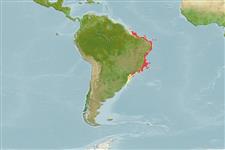Teleostei (teleosts) >
Tetraodontiformes (Puffers and filefishes) >
Tetraodontidae (Puffers) > Canthigasterinae
Etymology: Canthigaster: Greek, kanthos = the outer or inner corner of the eye, where the lids meet, 1646 + Greek, gaster = stomach (Ref. 45335); figueiredoi: Named in honor of José Lima de Figueiredo, for his contributions to the advancement of the taxonomy of Brazilian marine fishes, as well as for his long term encouragement and support to the authors (Ref. 43205).
Eponymy: Dr José Lima de Figueiredo (d: 1943) aka ‘Ze Lima’ is a Brazilian ichthyologist who is a former researcher and Curator of Fishes at the Zoological Museum of the University of São Paulo. [...] (Ref. 128868), visit book page.
Environment: milieu / climate zone / depth range / distribution range
Ecology
Marine; reef-associated; depth range 1 - 70 m (Ref. 43205). Tropical; 9°N - 33°S
Western Atlantic: southern Caribbean to Santa Catarina, Brazil, including the oceanic islands of Atol das Rocas and Fernando de Noronha.
Size / Weight / Age
Maturity: Lm ? range ? - ? cm
Max length : 12.0 cm NG male/unsexed; (Ref. 42064)
Dorsal spines (total): 0; Dorsal soft rays (total): 9 - 10; Anal spines: 0; Anal soft rays: 9. Differs from other Atlantic Canthigaster species by the long anterior extension of the lower horizontal dark stripe on the flank (composed of irregular horizontal and diagonal bars and originating as a solid stripe on the ventral caudal fin margin). This stripe reaches the pectoral fin base. Differs from C. jamestyleri by the presence of a dark caudal-fin margin, the absence of vertically oriented bars on the caudal fin, the possession of fewer stripes and spots on body especially on the dorsum, as well as by the absence of a small black irregular spot on the anal fin base (Ref. 43205).
Inhabits coral-rich as well as coral-poor areas, and areas with rocky bottoms (Ref. 43205). Maximum depth from Ref. 126840. Often in pairs, hovering over the reef during the day (Ref. 43205). Feeds on vegetation, sponges, crustaceans, and mollusks (Ref. 42064).
Life cycle and mating behavior
Maturity | Reproduction | Spawning | Eggs | Fecundity | Larvae
Moura, R.L. and R.M.C. Castro, 2002. Revision of Atlantic sharpnose pufferfishes (Tetraodontiformes: Tetraodontidae: Canthigaster), with description of three new species. Proc. Biol. Soc. Wash. 115(1):32-50. (Ref. 43205)
IUCN Red List Status (Ref. 130435: Version 2024-1)
Threat to humans
Harmless
Human uses
Fisheries: commercial; aquarium: commercial
Tools
Special reports
Download XML
Internet sources
Estimates based on models
Preferred temperature (Ref.
123201): 23.4 - 27.6, mean 27 °C (based on 177 cells).
Phylogenetic diversity index (Ref.
82804): PD
50 = 0.5000 [Uniqueness, from 0.5 = low to 2.0 = high].
Bayesian length-weight: a=0.03631 (0.01554 - 0.08482), b=2.88 (2.69 - 3.07), in cm total length, based on LWR estimates for this Genus-body shape (Ref.
93245).
Trophic level (Ref.
69278): 3.1 ±0.36 se; based on food items.
Resilience (Ref.
120179): High, minimum population doubling time less than 15 months (Preliminary K or Fecundity.).
Fishing Vulnerability (Ref.
59153): Low vulnerability (10 of 100).
Nutrients (Ref.
124155): Calcium = 107 [49, 256] mg/100g; Iron = 1 [0, 2] mg/100g; Protein = 18.1 [15.9, 20.3] %; Omega3 = 0.127 [0.061, 0.255] g/100g; Selenium = 35.6 [16.9, 79.5] μg/100g; VitaminA = 49.6 [13.6, 189.5] μg/100g; Zinc = 1.69 [1.08, 2.55] mg/100g (wet weight);
